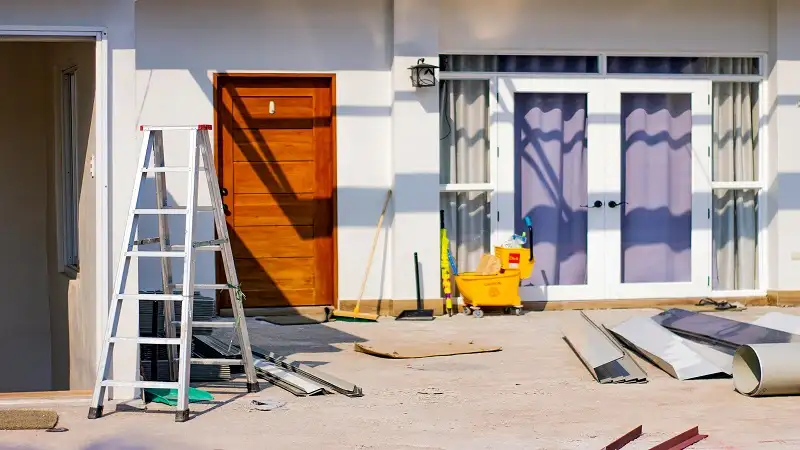A home is more than just a shelter — it’s your sanctuary, a reflection of your lifestyle, and a key to long-term comfort and stability. The Ultimate Home Maintenance and Upgrade Guide Yet, many homeowners overlook one crucial aspect of achieving a peaceful life: regular home maintenance and thoughtful upgrades. A well-maintained home doesn’t just look good; it functions efficiently, prevents costly repairs, and reduces daily stress.
In this comprehensive guide, we’ll explore how routine maintenance, strategic upgrades, and modern improvements can transform your living space into a stress-free haven. From seasonal checklists and smart home technologies to energy-saving upgrades and preventive care, this article will give you everything you need to maintain and elevate your home effectively.
The Hidden Benefits of Regular Home Maintenance
Before diving into specific tips and upgrades, it’s essential to understand why maintenance matters. Regular upkeep ensures your home remains safe, functional, and energy-efficient. Here are some key benefits:
-
Financial Savings: Preventive maintenance costs far less than emergency repairs. For example, fixing a leaky roof early can save you thousands in water damage.
-
Health and Safety: Proper ventilation, clean filters, and pest control keep your indoor air quality healthy and your home secure.
-
Enhanced Comfort: A well-maintained HVAC system, insulated windows, and working appliances make your daily life smoother.
-
Higher Property Value: A home in good condition always appeals more to potential buyers and maintains its resale value.
-
Peace of Mind: Knowing that your home systems are running efficiently eliminates unnecessary anxiety.
In short, regular maintenance is the foundation of stress-free living.
Seasonal Home Maintenance Checklist
Staying on top of maintenance becomes easier when broken down into seasonal tasks. Each season brings unique challenges, so here’s a comprehensive guide:
Spring: Renewal and Inspection
-
Roof and Gutters: Inspect for winter damage and clean out debris.
-
HVAC System: Schedule a professional tune-up before summer.
-
Landscaping: Trim trees and bushes away from the home’s structure.
-
Foundation Check: Look for cracks or signs of shifting.
-
Windows and Doors: Clean, re-caulk, and inspect seals for energy efficiency.
Summer: Energy Efficiency and Outdoor Care
-
Air Conditioning: Change filters monthly during heavy use.
-
Deck and Patio: Wash, reseal, or repaint surfaces to prevent weather damage.
-
Plumbing: Inspect outdoor faucets and sprinkler systems for leaks.
-
Pest Control: Address insect and rodent prevention early.
-
Energy Audit: Check insulation, appliances, and window coverings for cooling efficiency.
Autumn: Preparation for Cold Weather
-
Heating System: Have your furnace inspected and filters replaced.
-
Chimney and Fireplace: Clean and inspect for safety.
-
Gutters: Clear fallen leaves and ensure proper drainage.
-
Roof: Check for missing shingles or damage before snow hits.
-
Outdoor Furniture: Clean and store items to protect from winter damage.
Winter: Safety and Protection
- Pipes: Insulate exposed pipes to prevent freezing.
- Smoke and Carbon Monoxide Detectors: Test and replace batteries.
- Snow Removal: Keep pathways and driveways clear.
- Indoor Air Quality: Use humidifiers and air purifiers as needed.
- Attic Check: Ensure insulation is intact to avoid heat loss.
Following this seasonal maintenance cycle helps you stay proactive instead of reactive, keeping your home running smoothly year-round.
Essential Home Systems to Maintain
Certain parts of your home require regular attention to ensure safety and performance. The Ultimate Home Maintenance and Upgrade Guide Neglecting these can lead to major headaches:
-
Roof and Gutters: These are your home’s first line of defense against weather. Inspect twice a year.
-
Plumbing: Check for leaks, dripping faucets, and signs of water damage under sinks and around toilets.
-
Electrical System: Ensure circuits are functioning properly and avoid overloading outlets.
-
HVAC System: Schedule maintenance at least once a year for both heating and cooling.
-
Appliances: Clean refrigerator coils, check washing machine hoses, and maintain dishwashers.
By keeping these systems in check, you reduce repair emergencies and extend the lifespan of your home’s infrastructure.
Smart Home Upgrades for Effortless Living
Technology has revolutionized how we maintain our homes. Smart upgrades not only make your life more convenient but also enhance efficiency and security. Here are some modern upgrades to consider:
Smart Thermostats
Devices like Google Nest or Ecobee learn your temperature preferences and adjust automatically, saving energy and reducing utility bills.
Smart Security Systems
Install cameras, motion sensors, and doorbell cameras for peace of mind. Many systems can be monitored remotely from your phone.
Automated Lighting
Smart bulbs and motion sensors allow you to schedule or control lighting from anywhere — ideal for energy conservation.
Leak Detection Systems
Smart water sensors can detect leaks early, sending alerts directly to your phone before they cause costly damage.
Robotic Vacuums and Smart Appliances
Robotic cleaners, self-cleaning ovens, and smart fridges reduce your workload, leaving you more time to relax.
Home Energy Monitors
Track and optimize energy usage to identify which appliances consume the most power and reduce unnecessary waste.
These tech-driven solutions align perfectly with stress-free living, taking the burden of constant monitoring off your shoulders.
Energy-Efficient Upgrades That Pay Off
Reducing energy consumption not only lowers your bills but also contributes to a sustainable lifestyle. Here are some practical energy-saving upgrades:
-
Upgrade to LED Lighting: Uses up to 75% less energy and lasts longer.
-
Install Solar Panels: A long-term investment that significantly reduces electricity costs.
-
Energy-Efficient Windows: Minimize heat loss in winter and keep interiors cool in summer.
-
Tankless Water Heaters: Provide on-demand hot water while saving energy.
-
Insulation Improvements: Properly insulating walls, attics, and floors prevents wasted heating and cooling.
Energy-efficient upgrades are double rewards — they enhance comfort while cutting long-term costs.
Decluttering and Organizing for Mental Clarity
Home maintenance isn’t just about physical systems — it’s also about maintaining mental peace. A cluttered home can create subconscious stress. Here’s how to keep your environment organized:
-
Adopt the “One In, One Out” Rule: For every new item you bring in, remove one old item.
-
Create Storage Zones: Use labeled bins, vertical shelving, and under-bed storage to maximize space.
-
Digital Declutter: Organize files, bills, and home records on a cloud platform for easy access.
-
Weekly Cleaning Routine: Small, consistent cleaning habits prevent overwhelming messes.
A tidy home fosters clarity, focus, and relaxation — the true essence of stress-free living.
Sustainable Maintenance Practices
Adopting sustainable practices helps both your home and the planet. Try integrating these habits:
-
Use Eco-Friendly Cleaning Products: Non-toxic cleaners protect both your surfaces and your health.
-
Compost and Recycle: Reduce household waste by sorting properly.
-
Rainwater Harvesting: Collect rainwater for gardening and outdoor cleaning.
-
Plant Native Gardens: Require less maintenance and conserve water.
-
Energy-Efficient Appliances: Look for the ENERGY STAR label when replacing old appliances.
These sustainable habits create a greener, healthier home environment while reducing stress about your ecological footprint.
Budgeting for Home Maintenance and Upgrades
One reason homeowners delay maintenance is financial uncertainty. To stay ahead, build a maintenance fund:
-
Set Aside 1–3% of Your Home’s Value Annually: This covers routine maintenance and emergency repairs.
-
Prioritize Repairs by Urgency: Fix structural or safety issues first.
-
Plan Upgrades Seasonally: Take advantage of sales and rebates on appliances and materials.
-
Track Expenses: Use a home maintenance app or spreadsheet to monitor spending.
Budgeting not only makes maintenance manageable but also prevents sudden financial stress.
Hiring Professionals vs. DIY: Striking the Right Balance
While DIY repairs can save money, not all tasks are safe or practical. Here’s a quick guide:
DIY-Friendly Tasks
-
Painting and caulking
-
Replacing air filters
-
Cleaning gutters
-
Installing smart devices
Hire Professionals For
-
Electrical or gas-related work
-
Roofing and structural repairs
-
HVAC installation and servicing
-
Plumbing replacements
Knowing your limits ensures that jobs are done correctly and safely, reducing the risk of future stress.
Creating a Long-Term Home Care Plan
To keep everything running smoothly, create a home maintenance schedule. Include:
-
Annual inspections for HVAC, roof, and plumbing
-
Seasonal cleaning and organization
-
Long-term upgrade goals (e.g., solar installation, remodeling)
-
Emergency contact list for service professionals
Documenting and reviewing your plan once or twice a year ensures consistency and preparedness.
Conclusion: Building a Stress-Free Home for Life
A stress-free home is not built overnight — it’s the result of consistent maintenance, smart upgrades, and mindful living. The Ultimate Home Maintenance and Upgrade Guide By investing time and care into your home, you not only prevent costly surprises but also cultivate an environment that supports relaxation, efficiency, and happiness.
From routine checkups to sustainable upgrades, every step you take toward maintaining your home brings you closer to true peace of mind. Remember: your home should serve you — not the other way around. With this ultimate home maintenance and upgrade guide, you can create a space that’s not only functional and beautiful but truly stress-free.

